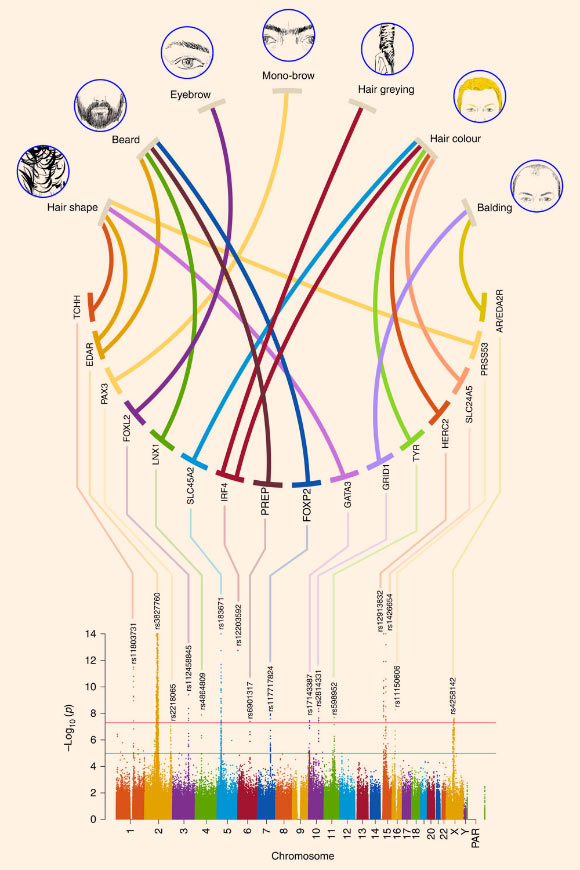The first gene identified for graying hair has been discovered by an international team of researchers.

At the top are shown drawings illustrating the seven hair features examined in this study; thick lines connect these features with the candidate genes identified in regions with single-nucleotide polymorphisms (SNPs) reaching genome-wide significant association. At the bottom is shown a composite Manhattan plot displaying all significantly associated SNPs for the hair features examined; the rs number of the SNP with the smallest P value is shown at the top of each association peak. Image credit: Kaustubh Adhikari et al., doi: 10.1038/ncomms10815.
The team, led by Prof. Andres Ruiz-Linares of University College London, analyzed a population of 6,630 people with varied ancestry across Latin America to identify new genes associated with hair color, graying, density and shape, i.e. straight or curly.
“Our study sample consists of 6,630 volunteers from the CANDELA cohort recruited in five Latin American countries (Brazil, Colombia, Chile, Mexico and Peru),” Prof. Ruiz-Linares and co-authors said.
“In these individuals, we performed a categorical assessment (in men and women) of: scalp hair shape (curliness), color, balding and graying as well as (in men) of beard thickness (that is, density), monobrow and eyebrow thickness.”
The gene identified for gray hair, IRF4 (interferon regulatory factor 4 gene), is known to play a role in hair color but this is the first time it has been associated with the graying of hair.
“IRF4 is involved in regulating production and storage of melanin, the pigment that determines hair, skin and eye color,” the scientists said.
“Hair graying is caused by an absence of melanin in hair so the scientists want to find out IRF4’s role in this process.”
Understanding how this gene influences hair graying could help the development of new cosmetic applications that change the appearance of hair as it grows in the follicle by slowing or blocking the graying of hair.
“We have found the first genetic association to hair graying, which could provide a good model to understand aspects of the biology of human aging,” Prof. Ruiz-Linares said.
“Understanding the mechanism of the IRF4 graying association could also be relevant for developing ways to delay hair graying.”
The team found additional genes associated with hair including EDAR (ectodysplasin A receptor) for beard thickness and hair shape, PRSS53 (protease serine S1 family member 53) for hair curliness, FOXL2 (forkhead box L2) for eyebrow thickness, and PAX3 (paired box gene 3) for monobrow prevalence.
“It has long been speculated that hair features could have been influenced by some form of selection, such as natural or sexual selection, and we found statistical evidence in the genome supporting that view,” said team member Dr. Kaustubh Adhikari, also of University College London.
“The genes we have identified are unlikely to work in isolation to cause graying or straight hair, or thick eyebrows, but have a role to play along with many other factors yet to be identified.”
The findings were published online today in the journal Nature Communications.
_____
Kaustubh Adhikari et al. 2016. A genome-wide association scan in admixed Latin Americans identifies loci influencing facial and scalp hair features. Nature Communications 7, article number: 10815; doi: 10.1038/ncomms10815







